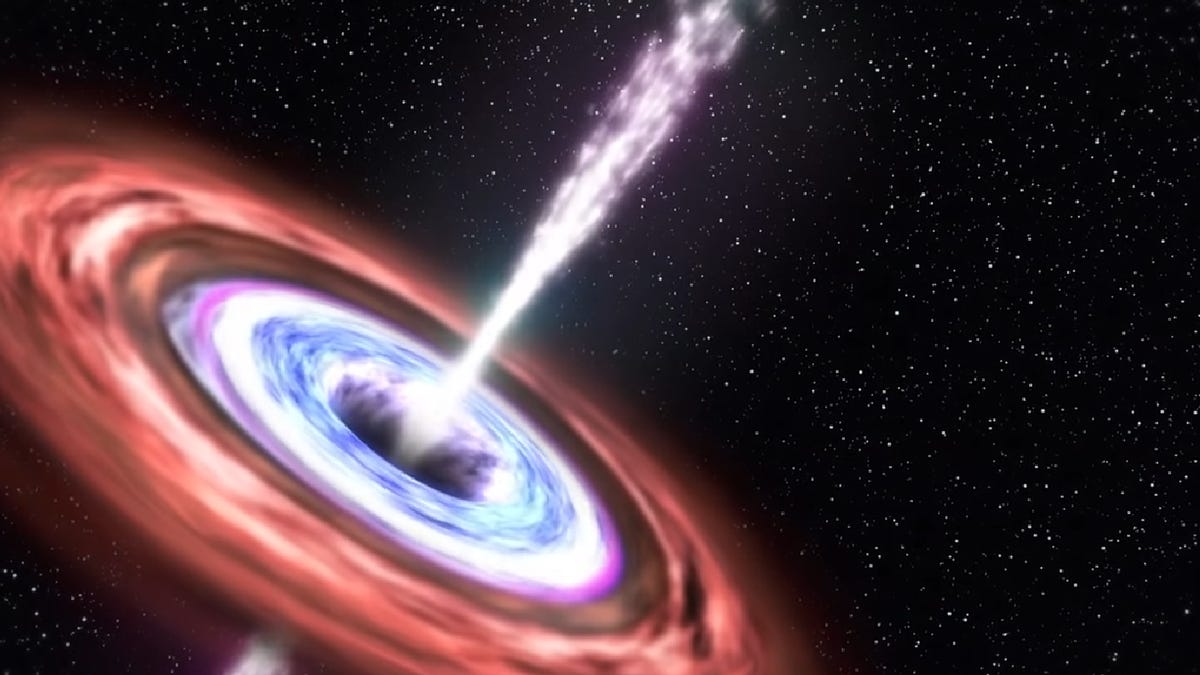NASA telescope spots black hole shrinking after devouring a star
A stellar meal provides tantalizing new evidence about black hole evolution.

About 10,000 light years away from Earth, a black hole is engaged in a stellar feast, devouring the gases of a nearby star -- and we've been watching.
The stellar-mass black hole, around 10 times more massive than our sun, was discovered after a humongous X-ray flare in March 2018. It was originally detected by a specialized instrument aboard the International Space Station, operated by the Japanese Aerospace and Exploration Agency, known as the Monitor of All-sky X-ray Image (MAXI). After the X-ray burst captivated astronomers, researchers at MIT, the University of Maryland and NASA swung another instrument on board the station to watch what happened to the black hole, nicknamed J1820.
It's embarrassing when people watch you eat, but J1820 was none the wiser as NASA swung the Neutron star Interior Composition Explorer (NICER) to monitor its buffet. NICER continued to detect waves of X-ray light bouncing away from the black hole, called "light echoes", which demonstrated how the black hole's size and shape was changing over time.
"NICER has allowed us to measure light echoes closer to a stellar-mass black hole than ever before," said first author Erin Kara.
The research, published on Jan. 10 in Nature, provides some tantalizing new evidence about the way a black hole evolves once it gobbles up a star. The major takeaway for the team was the the black hole's corona was shrinking.
Now, let's back up -- what does that actually mean? A black hole is a collapsed star with a core so dense that it has near-unimaginable gravitational power. Its gravity is so powerful that nothing -- no particles, no light -- can escape its pull. When a black hole begins to eat up a star, the star's gases swirl around its gravitational center in a ring known as an accretion disk. Above that you have the corona: an extremely energetic region of subatomic particles.
Because MAXI had caught the black hole's initial outburst, the team began studying the X-rays emitted from the black hole over a month, measuring how they bounced off the accretion disk. By measuring the X-rays from the initial outburst and those received later on (the "light echoes"), the team could determine that the corona had shrunk from around 100 kilometers (around 62 miles) to just 10 (around 6 miles).
"This is the first time that we've seen this kind of evidence that it's the corona shrinking during this particular phase of outburst evolution," said Jack Steiner, an astrophysicist with MIT.
The team noted that generally, light echoes are only seen bouncing away from supermassive black holes, like the one at the center of the Milky Way, rather than this comparatively small stellar mass black hole. However, here, NICER -- which was designed to examine faint, dense neutron stars -- was crucial to precisely measuring them.
But why the corona contracted in such a way remains a mystery. Steiner hypothesizes that as the gaseous accretion disk begins falling into the black hole, incredibly high pressures squeeze the corona's particles and thus that leads to the cosmic shrinkage we see.
Understanding the various parts of a black hole, such as the accretion disk or the corona, provide ways to study how black holes change over time. Although the study only looked at a stellar-mass black hole, at 10 times the mass of the sun, it may provide clues as to how black holes evolve to become "supermassive" and how that may influence the galaxies that swirl around them.
CES 2019: See all of CNET's coverage of the year's biggest tech show.
NASA turns 60: The space agency has taken humanity farther than anyone else, and it has plans to go further.

